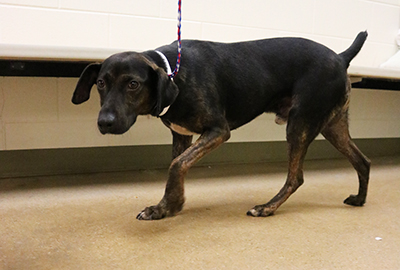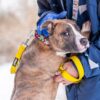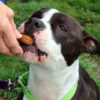This dog is a dog who has been fearful while in shelter and has taken longer than most to adjust to new situations. This dog should be given a significant amount of time to decompress and adjust once in the adopters home before adopters attempt to bring the dog new places or introduce new people or animals.
Understanding and responding to the dogs’ body language will be very important in helping this dog adjust comfortably to his/her new home. Dogs who are fearful may attempt to communicate and/or show their fears in a variety of ways including; panting, pacing, growling, backing away, cowering, freezing, shaking, being hyper-vigilant or even snapping.
How to Help your New Dog
Be understanding and patient. Don’t push your dog into encounters he is uncomfortable with or not ready for. We want to teach the dog to make the choice to be bold instead of force him to do something which could further increase his fear. You can help make him more comfortable by:
- Carrying treats with you and dishing them out whenever your dog sees something that might frighten him.
- Keeping encounters brief and positive. You should always end on a good note so your dog enjoys facing and working with his triggers.
- Saving meals for scary things. Hand feed your dog around or near what he is fearful of. Slowly increase the difficulty as he starts overcoming his fear. Example: If your dog is scared of going into the basement, hand feed every meal at the top of the stairs where he is a little unsure but not so nervous that he won’t go near the area. Let him have a few days getting comfortable at that spot then slowly move and sit one step down. Allow him to make the choice and be rewarded for being brave.
- Raising the value around things that frighten him the most by adding canned food, cheese or his favorite treats.
Additional Support
- Classes: Taking your dog to classes and working regularly on his training at home can really help build a dogs confidence. Take your dog to an obedience or agility class to give him a job to do and give him confidence around other dogs, people and in new places.
- Offer a Safe Place: Give your dog a safe place to go when he is uncomfortable such as a crate or a bedroom.
- Keep things Positive: Do not punish your dog for fearful behavior (even if it’s growling while backing away), instead, think about the best ways to modify or work on building his confidence around what he is scared of. Why? We do not want to change the symptom (shaking, growling, backing away, etc.), we want to change the underlying emotion (fear). If you were fearful of spiders and every time you saw a spider you yelled and immediately your closest friend yanked you away and yelled back to get you to stop yelling, your fear would likely increase because even your friend is scary when spiders are around! However, if every time you saw a spider your friend immediately handed you a hundred dollar bill (even if you were yelling), you’d likely soon be eager for a spider to appear and you’d start seeking them out. By pairing a reward with the fear, we create the positive association. Punishment is ineffective and unnecessary in situations where dogs are fearful.
- Work at your dog’s level: Avoid situations that would put you, your dog or anyone else in danger. Talk to us or call an in-home trainer if your dog growls, snaps, or lunges at people or other dogs, if his fear gets worse, or if he spends a lot of time shaking or hiding









